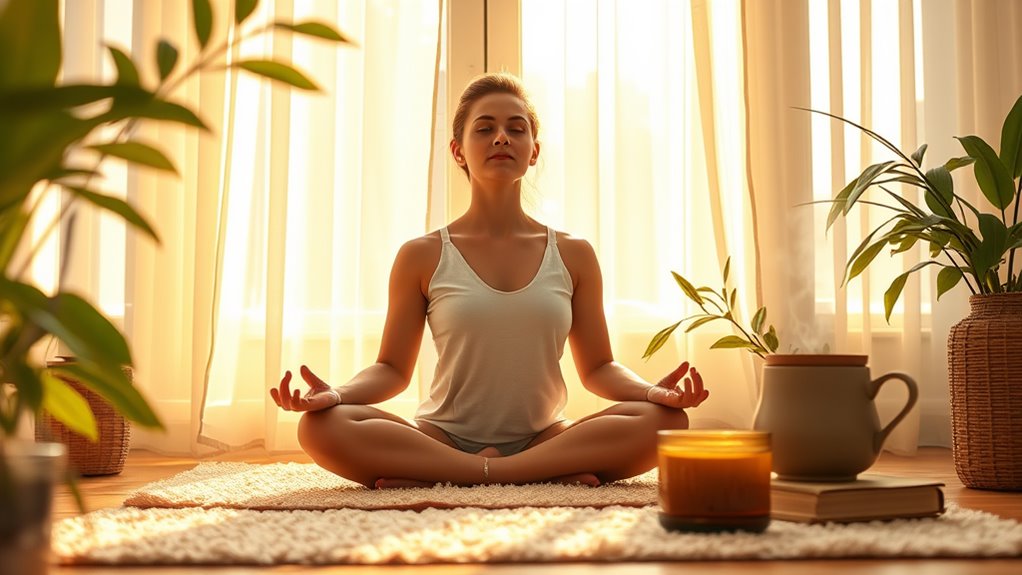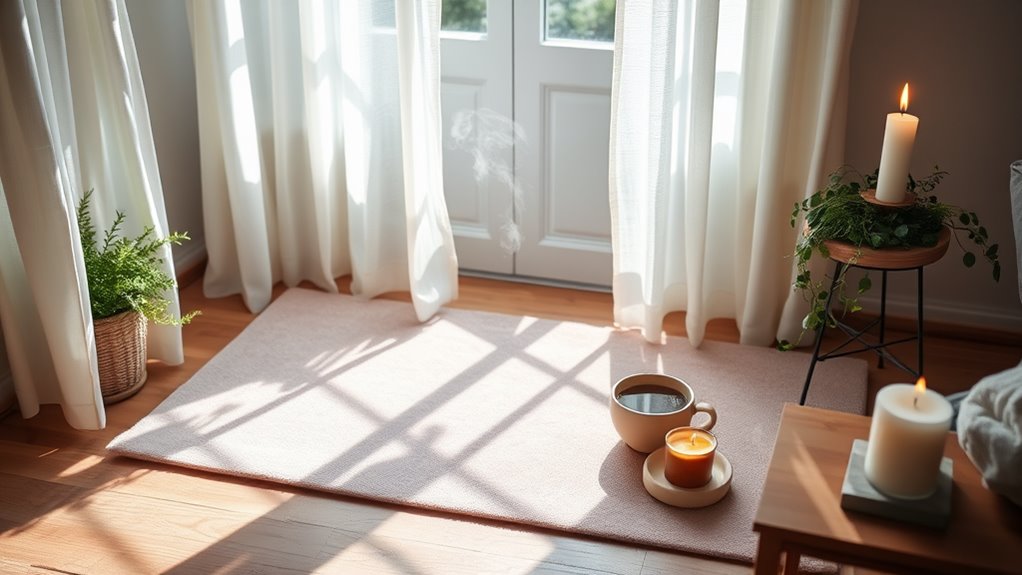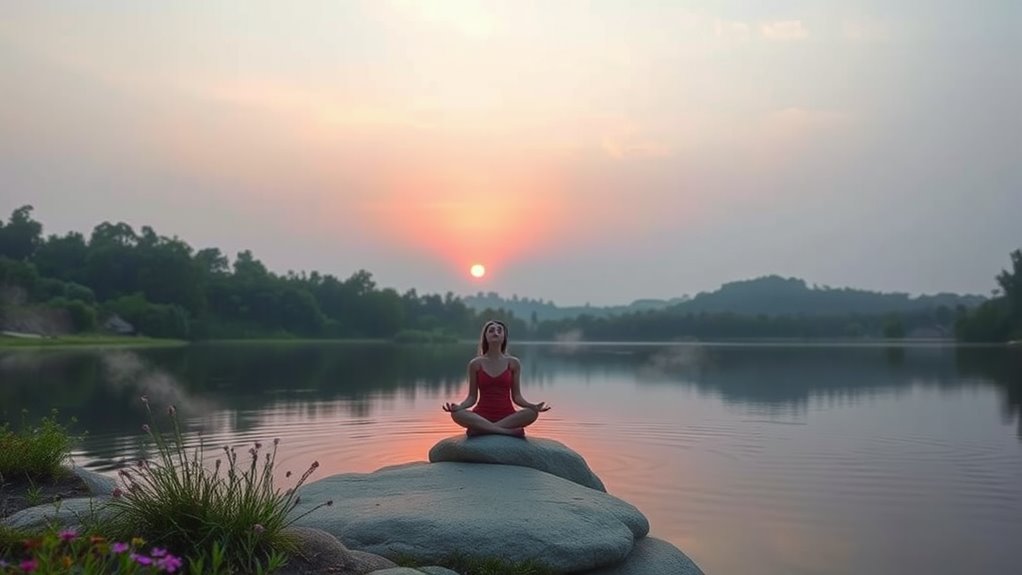Relaxation Techniques That Are Scientifically Proven to Work!
You can effectively reduce stress and enhance your well-being using scientifically proven relaxation techniques. Deep breathing exercises stimulate your parasympathetic nervous system, promoting relaxation. Progressive muscle relaxation helps you identify and release tension throughout your body. Mindfulness meditation encourages you to focus on the present moment, reducing anxiety. Additionally, guided imagery and yoga have been linked to improved emotional regulation and reduced stress. Don’t forget the benefits of nature exposure, which lowers cortisol levels, and journaling, which enhances self-awareness. Each technique offers unique advantages, and there’s much more to explore about how they work together for your relaxation journey.
Key Takeaways
- Deep breathing exercises activate the parasympathetic nervous system, reducing stress and promoting relaxation through focused breathing patterns.
- Progressive muscle relaxation systematically releases tension in muscle groups, enhancing awareness and overall well-being.
- Mindfulness meditation fosters present-moment awareness, leading to reduced anxiety and improved emotional regulation.
- Nature exposure significantly lowers stress levels, improves mood, and enhances cognitive function through activities like forest bathing and nature walks.
- Journaling boosts self-awareness and emotional regulation, providing clarity and emotional release through reflective writing.
Deep Breathing Exercises
Deep breathing exercises are a simple yet powerful way to promote relaxation and reduce stress. By focusing on your breathing patterns, you can tap into a natural physiological response that alleviates tension and enhances mental clarity.
When you consciously slow your breath, you activate the parasympathetic nervous system, which counteracts the stress response and encourages a state of calm.
To practice deep breathing, find a comfortable position, either sitting or lying down. Inhale deeply through your nose, allowing your abdomen to expand fully. Hold the breath for a moment, then exhale slowly through your mouth, feeling your body relax with each breath out.
Aim for a ratio of four counts in, four counts hold, and six counts out. This rhythmic pattern not only helps you focus but also promotes effective oxygen exchange.
Research shows that regular practice of deep breathing can lead to significant reductions in anxiety and stress levels. By mastering this technique, you’re equipping yourself with a valuable tool for managing daily challenges.
Integrate deep breathing into your routine, and you’ll likely notice profound improvements in your overall well-being and resilience against stress.
Progressive Muscle Relaxation
How often do you find yourself holding tension in your body without even realizing it? Progressive Muscle Relaxation (PMR) is a proven technique that helps you identify and release this muscle tension, triggering a powerful relaxation response. By systematically tensing and then relaxing different muscle groups, you gain a heightened awareness of where you carry stress.
Here’s a quick comparison of muscle tension and relaxation:
| Muscle Group | Tension Symptoms | Relaxation Signs |
|---|---|---|
| Shoulders | Tightness, discomfort | Looseness, ease |
| Jaw | Clenching, pain | Softening, release |
| Hands | Clenched fists | Open, calm |
| Abdomen | Tight, hard | Soft, relaxed |
| Legs | Stiffness, heaviness | Lightness, fluidity |
Engaging in PMR not only alleviates physical discomfort but also cultivates mental clarity. Research suggests that regularly practicing PMR can greatly reduce anxiety and improve your overall wellbeing. So, take a few moments each day to consciously work through each muscle group, embracing the shift from tension to relaxation. Your body—and mind—will thank you.
Mindfulness Meditation
Mindfulness meditation is a powerful practice that encourages you to focus on the present moment, fostering a sense of awareness and acceptance. By committing to mindfulness practices, you can cultivate a deeper understanding of your thoughts and emotions, allowing you to respond rather than react to stressors in your life.
Research shows that mindfulness meditation offers numerous mindfulness benefits, including reduced anxiety, improved emotional regulation, and enhanced cognitive flexibility. When you engage in regular practice, you train your brain to become more resilient to negative thoughts and feelings, promoting overall mental well-being.
To start, find a quiet space where you can sit comfortably. Close your eyes and concentrate on your breath, noticing each inhale and exhale. If your mind wanders, gently bring your focus back to your breath without judgment. This simple technique can be practiced for just a few minutes daily, gradually increasing the duration as you grow more comfortable.
As you continue to practice mindfulness meditation, you’ll likely notice a shift in your perspective, leading to a more balanced and fulfilling life. Embrace this journey, and let the transformative power of mindfulness enhance your everyday experiences.
Guided Imagery
Guided imagery is a relaxation technique that invites you to visualize calming and peaceful scenes, helping to ease stress and promote a sense of well-being. This method leverages powerful visualization techniques to create vivid mental imagery that can transport you to serene environments, such as a tranquil beach or a lush forest.
Research indicates that engaging in guided imagery not only reduces anxiety but also enhances emotional resilience.
To practice guided imagery, find a quiet space where you can comfortably relax. Close your eyes and take deep breaths, allowing your mind to focus on a specific scene. Imagine the details—the sound of waves, the scent of pine, or the warmth of sunlight on your skin.
As you immerse yourself in this mental imagery, notice how your body responds; tension may dissipate, and a sense of calm may wash over you.
For ideal benefits, consider integrating guided imagery into your daily routine. You might use audio recordings or apps that provide structured sessions.
Yoga and Stretching
Yoga and stretching are powerful practices that can greatly enhance your relaxation and overall well-being. Engaging in these activities not only improves flexibility but also fosters a deep connection between your mind and body.
Scientific research supports the numerous yoga benefits, including reduced stress, anxiety, and depression. When you practice yoga, you’re not just moving; you’re intentionally focusing on your breath, which activates the parasympathetic nervous system, promoting a state of calm.
Incorporating stretching routines into your daily life can further augment these effects. Simple stretches can alleviate muscle tension, improve circulation, and enhance your posture, all of which contribute to a more relaxed state.
Regularly practicing yoga and stretching encourages mindfulness, allowing you to be present in the moment and reducing the mental clutter that often leads to stress.
To maximize the benefits, consider establishing a consistent routine that combines various stretching techniques with yoga poses. This approach can help you develop a deeper understanding of your body’s capabilities and limitations, ultimately leading to greater mastery of both practices.
Embrace yoga and stretching as essential tools in your relaxation toolkit, and you’ll likely notice significant improvements in your overall quality of life.
Aromatherapy Techniques
Integrating aromatherapy techniques into your relaxation routine can further enhance the calming effects you’ve experienced with yoga and stretching. Aromatherapy utilizes essential oils derived from plants, each offering unique scent profiles that can influence your mood and well-being.
For instance, lavender is renowned for its soothing properties, promoting relaxation and reducing anxiety. A study published in the Journal of Alternative and Complementary Medicine found that inhaling lavender essential oil markedly decreased anxiety levels in participants.
To effectively incorporate aromatherapy, consider using a diffuser to disperse essential oils in your space. This method allows you to enjoy a consistent scent profile, creating a serene environment conducive to relaxation.
Alternatively, you can apply diluted essential oils topically—just remember to use a carrier oil to prevent skin irritation.
Experimenting with different essential oils can help you discover which scents resonate most with you. Citrus oils like bergamot can uplift your mood, while earthy scents like vetiver can ground you during stressful moments.
Nature Exposure
Spending time in nature can greatly reduce stress and improve your overall well-being.
Research shows that activities like hiking, gardening, or simply walking in a park not only boost your mood but also enhance your focus and creativity.
Benefits of Nature Exposure
A wealth of research highlights the profound benefits of nature exposure on mental and physical well-being. Engaging with natural environments can markedly reduce stress, anxiety, and depression. For instance, practices like forest bathing—immersing yourself in a forest environment—have been shown to lower cortisol levels and enhance mood. This immersive experience promotes mindfulness, allowing you to connect with your surroundings and find tranquility.
Wildlife observation also plays an essential role in boosting mental health. Watching animals in their natural habitats can foster a sense of awe and wonder, which is fundamental for psychological well-being. Studies indicate that spending time observing wildlife can improve attention spans and enhance feelings of connectedness to nature, further promoting emotional resilience.
Moreover, exposure to nature can enhance cognitive function. The restorative effects of green spaces can improve focus, creativity, and problem-solving skills, making it easier to tackle daily challenges.
By incorporating regular nature exposure into your routine, whether through forest bathing or wildlife observation, you can harness these benefits to foster a healthier, more balanced lifestyle.
Activities to Connect Outdoors
Exploring the great outdoors offers countless activities that can deepen your connection with nature and enhance your overall well-being. One effective way to achieve this is through nature walks. These walks not only allow you to immerse yourself in natural beauty but also encourage outdoor mindfulness, where you can focus on the sights, sounds, and smells of your surroundings.
Research shows that engaging with nature reduces stress and improves mood, making it a powerful tool for mental health.
To maximize your experience, consider setting intentions before your walk. This could be as simple as wanting to notice the different shades of green or to listen for bird calls. Such practices can heighten your awareness, promoting a sense of peace and grounding.
Additionally, try incorporating activities like journaling or sketching during or after your nature walks. This encourages reflection on your experiences, solidifying your connection to the environment.
Whether you’re hiking a trail or strolling through a local park, these activities cultivate a profound appreciation for nature, enhancing your overall sense of well-being and mastery over your relaxation techniques.
Embrace the outdoors; it’s a gateway to tranquility.
Journaling for Clarity
Journaling can be a powerful tool for gaining clarity in your thoughts and emotions. Engaging in reflective writing helps you process experiences and articulate feelings that might otherwise remain tangled in your mind. By putting pen to paper, you create a space for emotional release, allowing you to examine your inner landscape more objectively.
Research supports the benefits of journaling, showing that it can enhance self-awareness and improve emotional regulation. When you jot down your thoughts, patterns and themes often emerge, revealing insights that can guide your decisions and behaviors. This practice not only fosters clarity but also promotes mental well-being by reducing stress and anxiety.
To maximize the effectiveness of your journaling, establish a routine. Whether it’s a few minutes each day or a dedicated weekly session, consistency is key. Don’t worry about grammar or structure; focus on honesty and openness.
You might explore prompts that resonate with you or simply free-write about your day. Over time, you’ll likely find that your journaling practice evolves, leading to deeper understanding and mastery over your emotional landscape.
Frequently Asked Questions
How Often Should I Practice These Relaxation Techniques for Best Results?
To achieve ideal results, you should aim for daily practice of relaxation techniques. Consistency enhances their effectiveness, fostering a deeper sense of calm and resilience. Even short sessions can greatly impact your overall well-being.
Can Children Benefit From These Relaxation Techniques?
Absolutely, children can benefit immensely from mindfulness and breathing exercises. These practices enhance focus, reduce anxiety, and promote emotional regulation, helping your child develop essential coping skills for life’s challenges. Start integrating them today!
Are There Any Side Effects to These Relaxation Methods?
Imagine sinking into a soft cloud, yet, while most relaxation methods are safe, some can cause side effects like dizziness or fatigue. It’s essential to listen to your body and adjust your practice accordingly.
How Quickly Can I Expect to See Results?
You can expect immediate benefits from relaxation techniques, often feeling calmer within minutes. However, for long-term effects, consistent practice over weeks or months is essential to truly master the techniques and enhance your overall well-being.
Can These Techniques Be Used in Conjunction With Other Therapies?
Combining therapies can enhance overall effectiveness. Holistic approaches, integrating relaxation techniques with other treatments, often lead to improved outcomes. It is crucial to collaborate with healthcare providers to tailor a plan that suits your needs.





